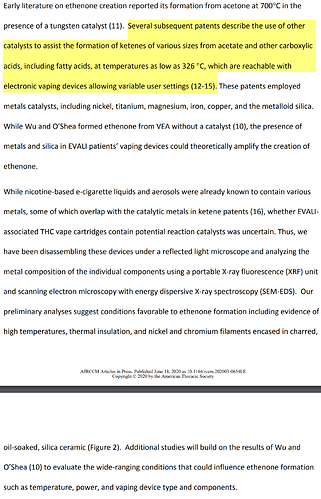The current state of knowledge is that ketene (from vit E) is unlikely to be the culprit because it’s only formed at high temps, well above any temps people vape disty at, including dry hits of cannabis vape coils.
The reason some studies find ketne from vit E is they’re using nic vape carts (e-cigarettes) and pure vit E. Nic vapes, especially sub-ohm, can and do reach into temps exceeding 600-700’c (up to 1,000’C) on dry hits and therefore do produce ketene gas.
It’s a fact vit E alone won’t product ketene gas until it’s heated to at least 650’c…
It’s not at all clear vit E is the culprit of EVALI. But because it’s an easy target it gets the blame…without getting proven to be the cause.
This is borne out because although drums and drums of vit E are still sold in LA for vape juice today, there are no more recorded EVALI cases. Also, the first use of vit E for vaping started in early 2018, but the first EVLI case wasn’t until 13 months later in early 2019 and 2,000 miles away. Occam’s Razor…
So far it’s been found EVALI is not caused by vit E affecting lung surfactanct, it’s not caused lipoid pneumonia from vit e, and thus far no research has found its caused by ketene gas (from vit E) because cannabis vape batteries just don’t get that hot and there is no residual ketene gas (if it’s created at all) from lung fluid samples.
Does “Dry Hit” Vaping of Vitamin E Acetate Contribute to EVALI?
Simulating Toxic Ketene Formation During E-Cigarette Use
This study has an interesting paragraph regarding metals and other catalysis in how they may affect ketene production at 326’C. Which is hotter than vape pens get unless they’re malfunctioning or someone is sucking on an empty cart with the volts as high as possible:
Potential of Ethenone (ketene) to Contribute to E-cigarette, or Vaping, Product Use–Associated Lung Injury
And check out these studies as well:
Is EVALI the new scapegoat for every abnormal chest imaging?
Measurement of heating coil temperature for e-cigarettes with a “top-coil” clearomizer
E-cigarette, or Vaping Product-Associated Lung Injury (EVALI): Seeking the Toxicant(s)





